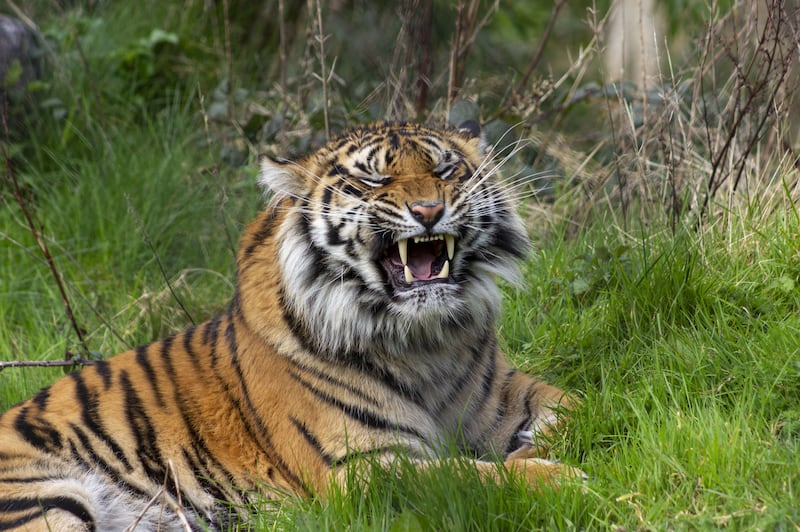A new Sumatran tiger at Fota Wildlife Park in Co Cork is being introduced to the public today after arriving in Ireland as part of a programme to breed the endangered species.
Janbi, a female, arrived from Heidelberg Zoo in Germany on February 21st and after spending a few weeks adjusting to her new surroundings, is ready to make her first appearance on St Patrick’s weekend.
Fota Wildlife Park began breeding big cats in 1984 when it started its successful Cheetah Breeding Programme but more recently it has started to participate in breeding programmes for two other threatened big cats, the Sumatran tiger and the Asiatic Lion.
Director Sean McKeown explained that the park acquired an additional 27 acres in 2003 and after planting it with native trees, they developed it into the Asian Sanctuary a decade or so later, facilitating the arrival of Sumatran tigers in 2014 and the Asiatic lions in 2016.
READ MORE
“We ae delighted to be able to introduce a new female Sumatran tiger named Jambi to the public this weekend – she arrived recently from Heidelberg Zoo in Germany and after a transition period she has settled into her new habitat in the Asian Sanctuary,” he said.
Mr McKeown said Jambi has come to Fota Wildlife Park as part of a recommended move from the European Association of Zoos and Aquaria’s (EAZA) endangered breeding programme (EEP) for Sumatran tigers, which Fota Wildlife Park has been involved with for almost a decade.
“We became involved in the Endangered Breeding Programme in 2014 when the park received its first Sumatran tigers, a male, Denar, and a female, Dourga, and this pair produced two offspring, a female, Dharma, in May 2017 and a male, Dash, in June 2019.”
Mr McKeown explained that in order to avoid inbreeding and to maintain as much genetic diversity in the EEP breeding programme as possible, the tigers are often moved between zoological parks to breed with different mates.
“When Jambi arrived at Fota Wildlife Park on February 21st as part of an EEP breeding programme move, it also saw Fota’s male tiger Denar transferred to Cottbus Zoo in Germany on the same day to breed with a female Sumatran tiger there,” he said.
“Last year as part of the programme, Dourga moved to West Midlands Safari Park and her male offspring Dash, born at Fota, moved to Chester Zoo on the same day. Dash quickly settled in and mated with the resident female Kasarna which resulted in the birth of two cubs in January.”
Mr McKeown explained the Sumatran tiger is one of the rarest subspecies of tigers in the world and was classified as critically endangered by the International Union for Conservation of Nature (IUCN) in 2008 after it was estimated that there are fewer than 350 individuals left in the wild.
“They are the only island species of tiger left – there was a Bali tiger and a Javan tiger, but they are now extinct and there was also a Caspian tiger around eastern Turkey and northern Iran, but the last one was shot in the 1950s so it’s critically important to conserve the Sumatran tiger.

“The Sumatran tiger is smaller than the Bengal tiger and the Siberian tiger, but they are probably the most dangerous of all tigers – they might be small, but they are very effective killers, they are fast, but they also have a serious temperament: when they look at you, you are just walking meat.
“The Sumatran tiger is genetically quite distinct – although the mainland tigers like the Bengal tiger and the Siberian tiger have some genetic differences, they are more closely related so from a genetic diversity point of view the Sumatran tiger is the most important to breed and save.”
Mr McKeown said Fota was committed to an overall breeding programme, which is managed to keep the Sumatran tiger population as genetically diverse as possible while building up to a stable population of around 300 animals having already managed to breed about 150 in captivity.
Meanwhile Jambi is due to make her first public appearance at Fota this weekend alongside the other two non-breeding Sumatran tigers, a male Batak and a female, Mayang and they hope to mate her with a young male who is expected to arrive in Fota later this year.
Fota lead ranger Julien Fonteneau revealed Jambi is settling in well. “Introducing a new tiger to the current streak is a very specialised process that requires a high degree of training and husbandry. At first, the new tiger must be allowed to acquaint itself with their new environment.
“Jambi was quiet for the first few days, but she is now a lot more confident, and we have started tong feeding her and doing some basic training. We introduce the tigers through the mesh during this stage, and the three are getting on well,” he said.











